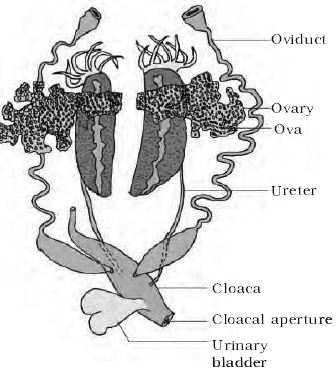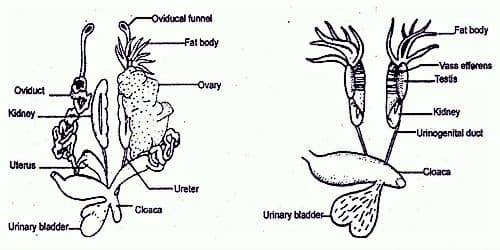Frog female reproductive system:
The female reproductive organs include a pair of ovaries (Figure). The ovaries are situated near kidneys and there is no functional connection with kidneys. A pair of oviduct arising from the ovaries opens into the cloaca separately. The female reproductive system has a pair of ovaries, a pair of oviducts that open into the cloaca individually.
A mature female can lay 2500 to 3000 ova at a time. Gametes come out through the cloacal aperture. Ovaries shed the mature eggs in the coelomic cavity. Eggs enter oviducal funnel to reach oviduct. Eggs enter cloaca through oviducts of both sides. External fertilization is seen in frogs and occurs in water.
Fertilization is external and takes place in water. Development involves a larval stage called tadpole. Tadpole undergoes metamorphosis to form the adult. Frogs are beneficial for mankind because they eat insects and protect the crop. Frogs maintain ecological balance because these serve as an important link of the food chain and food web in the ecosystem.

Egg formation
Eggs are produced from the germinal epithelium. Frog’s larvae are aquatic, gill breathing. Metamorphosis takes place in tadpoles when the frog becomes lung breathing and terrestrial.
They become grown-up after passing through the following stages,
- Multiplication phase: Genital epithelium divides into several cells called oogonia by mitotic division.
- Growth phase: After absorbing nutrients, these cells become big which are called major oocytes. Here, the chromosome number is 22.
Female reproductive organ
It consists of following parts
Ovary: Paired yellowish black colored formation covered by a membrane of peritoneum known as mesovarium. This is full of eggs throughout reproduction term. Ovaries are little structures consisting three layers, outer theca external, middle germinal epithelium and inner theca internal which consist blood cells, muscle cells, nerves cells and germinal epithelium.
Oviduct: It is an extended curved duct with the substantial wall that is not associated with kidneys. It is divided into three parts.
- Oviduct funnel: wide opened construction, situated in the forward part of body cavity near lungs and oesophagus. The ciliated wide opening is known as the ostium.
- Middle region: coiled part with thin body wall in some area and thick in the remaining area. It consists some glands which secrete albumen that hardens ova.
- Uterus: It is the middle part near the cloaca which is wide, thin-walled formation and forms uterus.












